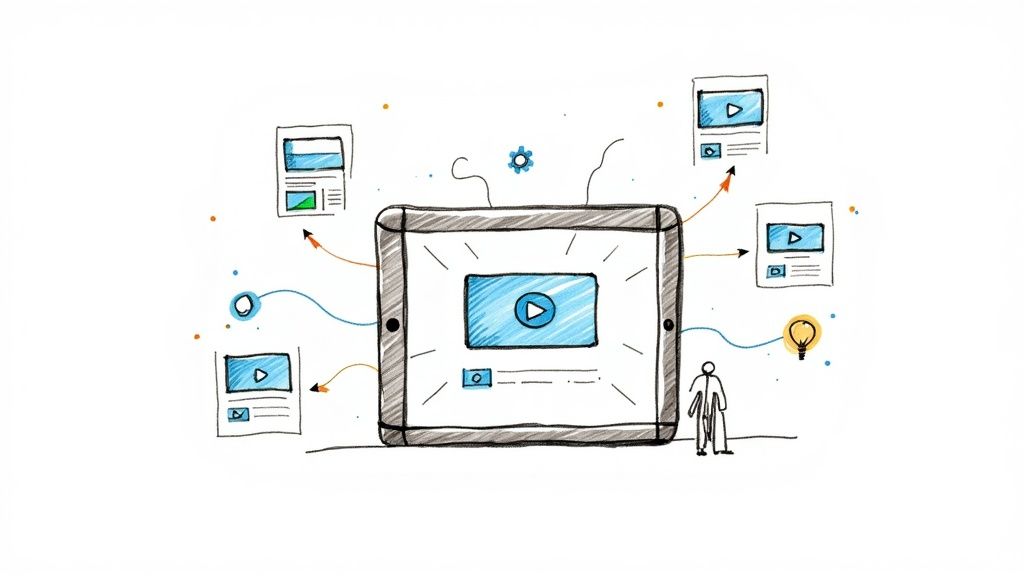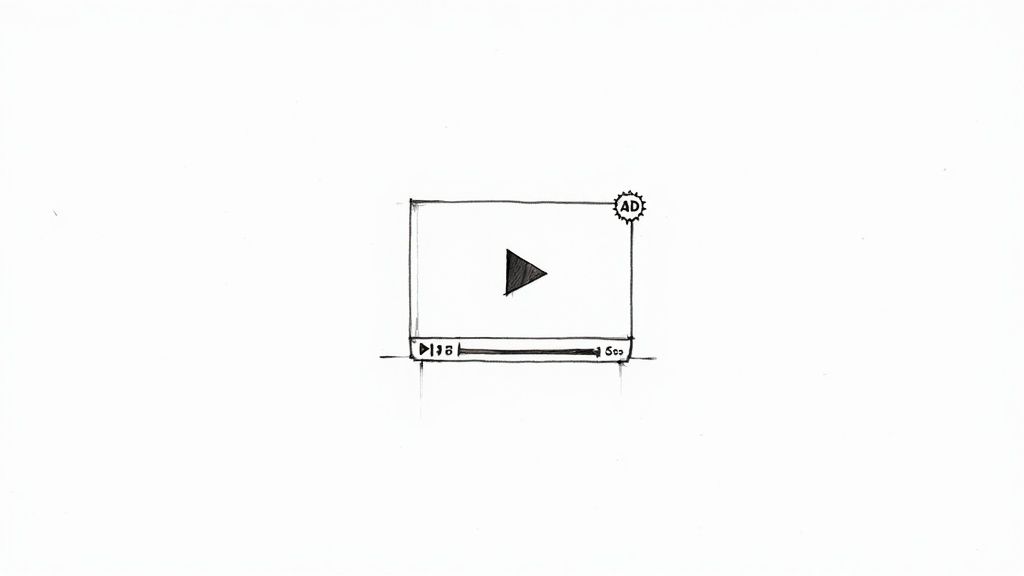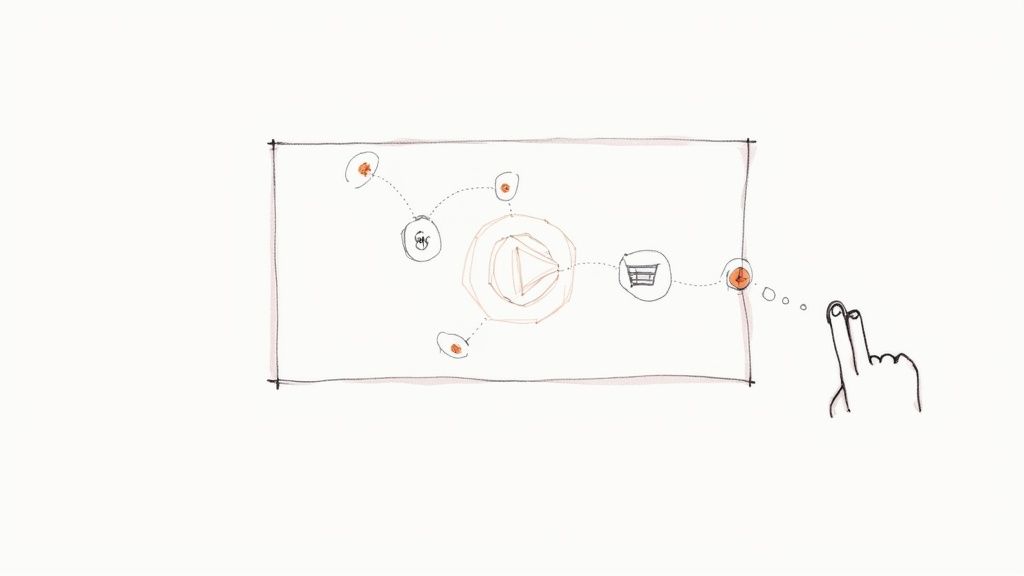
10 Powerful Examples of Video Ads for Training in 2025
In a world of shrinking attention spans, standard corporate training videos often struggle to keep employees engaged. The solution is surprisingly simple: borrow proven tactics from the world's most successful advertisers. This article explores 10 powerful examples of video ads, breaking down the specific strategies that make them so effective and memorable. We will show you how to apply these same principles to your corporate training and development programs, transforming passive viewing into active, participatory learning.
By understanding what truly captures and holds an audience's attention, you can create more impactful and measurable training experiences. The goal isn't just to inform, but to drive real behavioral change and skill acquisition within your organization. We will deconstruct everything from short bumper ads to fully interactive experiences, providing a blueprint for creating content that resonates. To see how these principles are applied in a purely commercial context, it's beneficial to analyze various high-converting YouTube ad examples to understand the core mechanics of audience persuasion. This guide will help you adapt those successful advertising frameworks to build training that works.
1. Pre-roll Video Ads
Pre-roll video ads are short advertisements that play automatically before a user’s selected video content begins. They are a staple of platforms like YouTube, Hulu, and other video streaming services. These ads can be either skippable after a few seconds or non-skippable, forcing a brief but guaranteed exposure to the brand’s message.

In a corporate training context, the pre-roll format is excellent for introducing a learning module. A short, compelling video at the start of a training series can set expectations, highlight key learning outcomes, or present a problem that the upcoming training will solve. This primes the learner and focuses their attention from the very beginning.
Why It Works & Key Tactics
Pre-roll ads excel at capturing attention in the first few critical seconds. Because the viewer is already committed to watching the subsequent content, the ad has a captive audience. This makes it one of the most direct examples of video ads for establishing the "why" behind the training.
Strategic Insight: The first 3-5 seconds are everything. You must immediately establish relevance or intrigue. For training content, this means posing a common workplace challenge or highlighting a key skill the learner will acquire.
Actionable Takeaways for Training & Development
- Problem-First Hook: Start your training intro by stating a common pain point. For example, "Struggling with low employee engagement in virtual training? This module will show you how to fix it."
- Micro-Learning Teaser: Use the pre-roll format to offer a single, powerful tip from the upcoming training program. This provides immediate value and creates a desire to learn more.
- Set Clear Objectives: Use this initial video to clearly state the learning objectives for the module, ensuring the employee understands the value of their time investment.
2. Mid-roll Video Ads
Mid-roll video ads are advertisements inserted into the middle of video content, similar to a commercial break on traditional television. These ads are typically found in longer-form videos on platforms like YouTube (for videos over 8 minutes), Twitch streams, and podcast episodes. Their placement is designed to capture viewer attention when they are already invested in the content.
This format is particularly effective for breaking up longer corporate training sessions. Imagine a 30-minute compliance training video; a mid-roll "ad" can be placed at a natural transition point to reinforce a key concept, introduce a related topic, or prompt a short interactive exercise, preventing learner fatigue and re-engaging their focus.
Why It Works & Key Tactics
Mid-roll ads capitalize on peak viewer engagement. Unlike pre-roll ads that can be perceived as a barrier to content, mid-roll insertions appear when the audience is already committed. This context makes them powerful examples of video ads for reinforcing key messages or introducing supplementary tools without disrupting the initial flow of learning.
Strategic Insight: Placement is paramount. A poorly placed mid-roll ad can feel intrusive. For training, align these "breaks" with natural lulls or chapter changes in the content to maintain a positive learning experience.
Actionable Takeaways for Training & Development
- Contextual Reinforcement: Ensure the mid-roll content is directly relevant. In a sales training video, a mid-roll clip could highlight a success story using the technique just discussed.
- Announce the Break: Prepare the learner by having the instructor announce a short interactive break. For example, "Before we move on, let's pause for a quick knowledge check on what we've covered."
- Promote Further Learning: Use mid-roll insertions to promote a related advanced certification or a downloadable resource that builds upon the video’s content.
3. Bumper Ads
Bumper ads are ultra-short, non-skippable video advertisements that last for six seconds or less. Found primarily on platforms like YouTube, they are designed to deliver a concise, memorable brand message or impression. Their brevity and non-skippable nature make them ideal for building brand recall and reinforcing key concepts through high-frequency exposure.
In the corporate training space, bumper ads serve as powerful micro-learning reinforcements. For example, a company launching a new compliance protocol could use a series of six-second videos to remind employees of a single, critical rule. These can be inserted between modules or sent out periodically to keep important training top-of-mind long after the initial session ends.
Why It Works & Key Tactics
Bumper ads succeed through simplicity and repetition. Their six-second constraint forces learning designers to distill their message to its absolute core, ensuring clarity and impact. This format is a potent tool among the different examples of video ads for achieving high message frequency without causing viewer fatigue.
Strategic Insight: The goal is not a complex narrative but a single, sticky idea. A training bumper ad shouldn't teach a full concept; it should reinforce one. Focus on a single keyword, a visual cue, or a key statistic from your learning module.
Actionable Takeaways for Training & Development
- Single-Focus Message: Dedicate each bumper ad to one specific learning objective or safety tip. For instance, an ad could simply show the phrase "Lock Before You Leave" with company branding.
- Create a Thematic Series: Develop a sequence of bumper videos that build upon each other. Each one can highlight a different step in a process or a benefit of a new software tool, creating a cohesive learning campaign.
- Visual & Auditory Hooks: Use a memorable sound effect or a striking visual that employees will instantly associate with the training topic. This builds a strong cognitive link to the learning material.
4. Shoppable/Interactive Video Ads
Shoppable or interactive video ads transform passive viewing into an active experience, allowing users to engage directly with content through clickable elements. While prominent in e-commerce for direct purchasing, this technology is a game-changer for corporate training, enabling features like in-video quizzes, polls, and branching scenarios that guide learners based on their responses.

For L&D professionals, this means turning a standard training video into a dynamic assessment tool. For example, a compliance training module can include clickable hotspots to define key terms or a quiz to check comprehension before proceeding. This approach provides immediate feedback and robust data on learner engagement and knowledge retention.
Why It Works & Key Tactics
Interactive videos are powerful because they demand participation, boosting engagement and memory. The ability to collect direct user input makes them one of the most effective examples of video ads for measuring learning outcomes and personalizing content paths. This moves training from a one-way lecture to a two-way dialogue.
Strategic Insight: The goal isn't just interaction; it's meaningful engagement. Every clickable element should serve a purpose, either to reinforce a key concept, assess understanding, or provide supplemental resources, thereby deepening the learning experience.
Actionable Takeaways for Training & Development
- Embed Knowledge Checks: Add short, non-graded questions or polls throughout a video to keep learners focused and gauge real-time comprehension.
- Create Branching Scenarios: Build interactive simulations for sales or customer service training where learners choose a response and see the consequences, creating a safe "learn-by-doing" environment.
- Add Resource Hotspots: Place clickable icons over complex topics or tools that link to detailed guides, policy documents, or glossaries, providing on-demand support. Platforms like Mindstamp are designed specifically to add these interactive layers to your training videos.
5. User-Generated Content (UGC) Video Ads
User-Generated Content (UGC) video ads leverage authentic content created by users and customers rather than by a professional production team. These ads feature real people sharing their experiences, creating genuine testimonials that build trust and resonate more deeply with audiences than polished brand messaging.
In corporate training, UGC is a powerful tool for social learning and engagement. A company could encourage employees to submit short videos demonstrating how they applied a new sales technique or a safety protocol in their daily work. These real-world applications provide authentic, peer-to-peer learning experiences that reinforce training concepts far more effectively than top-down instruction alone.
Why It Works & Key Tactics
UGC thrives on authenticity and social proof. When employees see their peers, not actors, successfully applying new skills, it lowers skepticism and builds immediate credibility. This approach turns successful employees into internal champions, making it one of the most persuasive examples of video ads for driving adoption of new processes.
Strategic Insight: Authenticity is the currency of UGC. The goal is not to create a perfectly polished video but to showcase genuine experiences. Highlighting unscripted, real-world examples from employees makes the learning material relatable and practical.
Actionable Takeaways for Training & Development
- Launch a "Show Your Skills" Campaign: Incentivize employees to submit videos of them successfully using new skills learned in training modules. Feature the best submissions in company-wide communications.
- Create Peer-to-Peer Testimonials: Ask high-performing team members to record short video testimonials about how a specific training program helped their career development or daily workflow.
- Source Content for Onboarding: Crowdsource short "welcome" videos from team members to include in new hire onboarding, fostering a sense of community and shared culture from day one.
6. Explainer Video Ads
Explainer video ads are educational, narrative-driven videos that break down complex products, services, or concepts into easy-to-understand segments. Often using animation or streamlined live-action, they clearly communicate value propositions and how a solution works, making them a cornerstone for B2B brands.

In a corporate training context, explainers are invaluable for introducing new software, demonstrating updated internal processes, or outlining complex compliance standards. For example, an HR department could create an animated explainer to detail a new benefits enrollment platform, guiding employees through the steps in a clear and engaging format that reduces support tickets.
Why It Works & Key Tactics
Explainer videos succeed because they address the viewer's core question: "How does this work and why should I care?" By focusing on education, they build understanding and demonstrate the value of a new process or tool. This approach makes them one of the most effective examples of video ads for driving adoption and ensuring procedural consistency.
Strategic Insight: The goal is clarity, not complexity. An effective explainer simplifies a difficult concept, making the learner feel smart and empowered. For training, this means avoiding jargon and focusing on the direct, tangible benefits of adopting the new process or tool.
Actionable Takeaways for Training & Development
- Structure as Problem-Solution-Benefit: Frame your video by first introducing a common employee challenge, then present your process or tool as the solution, and finally, show the positive outcome.
- Visualize the Abstract: Use animation and motion graphics to make intangible concepts, like data security protocols or company values, visible and easier to grasp.
- Embed Interactive Checkpoints: Use a platform like Mindstamp to insert questions or polls within the explainer video. This ensures employees are actively engaging with and comprehending critical training material.
7. Storytelling/Emotional Video Ads
Storytelling or emotional video ads build deep connections with audiences by focusing on narrative-driven content that prioritizes human experience and values over direct product promotion. Brands have mastered this approach to foster long-term loyalty by creating memorable, emotionally resonant content.

In a corporate L&D context, this technique is powerful for framing complex topics like leadership, ethics, or diversity and inclusion. Instead of presenting dry rules, a training module can feature a relatable story about an employee navigating a difficult ethical dilemma. This narrative approach makes the concepts more tangible and emotionally engaging, which significantly boosts learner retention and application.
Why It Works & Key Tactics
Emotional storytelling works because it taps into fundamental human psychology, making abstract concepts feel personal and urgent. By creating a narrative arc with relatable characters, you transform passive viewers into engaged participants who are invested in the outcome. This makes it one of the most effective examples of video ads for internal communications and company culture building.
Strategic Insight: The goal is connection, not just comprehension. A successful training story makes the learner feel understood. This means the story must reflect the genuine challenges and triumphs your employees experience, creating a sense of shared purpose.
Actionable Takeaways for Training & Development
- Create Relatable Protagonists: Develop characters for your training scenarios that reflect your employee demographics and face realistic workplace challenges.
- Focus on a Central Conflict: Structure your training video around a single, clear problem and its resolution. For example, a new manager learning to give difficult feedback.
- Use Music and Pacing to Guide Emotion: Strategically use a soundtrack and editing to build tension, create moments of reflection, and underscore key learning moments in the narrative.
8. Live Streaming Video Ads
Live streaming video ads are advertisements delivered during real-time video broadcasts. Unlike pre-recorded content, they capitalize on the immediacy and interactivity of live events on platforms like YouTube Live and LinkedIn Live. This format allows for authentic, timely engagement opportunities, such as sponsored live workshops or expert Q&A sessions.
For corporate training, live streaming is invaluable for virtual instructor-led training (VILT), launching new compliance protocols, or demonstrating complex software in real time. A company could host a live Q&A with a subject matter expert to accompany a new e-learning module. This not only disseminates critical information but also builds a community around the learning experience, fostering direct interaction and immediate feedback from employees.
Why It Works & Key Tactics
Live streaming builds engagement through unscripted, direct interaction. Learners feel more connected to the content because they are part of a shared, fleeting experience. This makes live streaming one of the most powerful examples of video ads for creating a dynamic learning environment and driving immediate participation.
Strategic Insight: Authenticity trumps perfection. Live training thrives on genuine interaction, not flawless production. Encourage audience participation through live polls, chat questions, and real-time shout-outs to make the training feel like a two-way conversation rather than a one-way lecture.
Actionable Takeaways for Training & Development
- Promote Extensively Beforehand: Build anticipation for your live training event across internal channels like Slack, email newsletters, and intranet portals to ensure maximum attendance.
- Integrate Interactive Elements: Use platform features like live polls, Q&A modules, and chat to actively involve your audience. For example, poll employees on their current understanding of a topic before diving in.
- Repurpose the Content: Record the live session and use a platform like Mindstamp to add interactive elements like a table of contents, questions, and resources. This extends the value of the event and creates an on-demand training asset.
9. Personalized/Dynamic Video Ads
Personalized video ads are dynamically customized for individual viewers based on their behavior, preferences, and previous interactions. Leveraging data, these ads deliver highly targeted messages that feel uniquely crafted for each recipient, dramatically increasing relevance and engagement.
In a corporate training setting, personalization transforms generic learning into a bespoke experience. A training platform could dynamically insert an employee's name, role, or specific performance data into a video module, making the content directly applicable to their individual development path and boosting knowledge retention.
Why It Works & Key Tactics
Personalization cuts through the noise by making the learner the protagonist of the training. This hyper-relevance fosters a strong connection and makes the message feel less like a generic requirement and more like a helpful, tailored development opportunity. This level of customization makes it one of the most powerful examples of video ads for driving engagement and skill development.
Strategic Insight: True personalization goes beyond just using a name. It should reflect the learner's journey and context. For training, this means tailoring content based on quiz scores, job function, or previously completed courses to address specific knowledge gaps.
Actionable Takeaways for Training & Development
- Role-Specific Onboarding: Create a single onboarding video template that dynamically populates with department-specific information, team member introductions, and goals relevant to the new hire's role.
- Progress-Based Nudges: Use personalized video messages to congratulate employees on completing a module or gently remind them of outstanding training, referencing their specific progress.
- Data-Driven Skill Paths: Dynamically generate a video that outlines a recommended learning path for an employee based on their performance reviews or stated career aspirations. Learn more about the power of video personalization on mindstamp.com.
10. 360-Degree/VR Video Ads
360-degree and Virtual Reality (VR) video ads offer a deeply immersive experience, allowing viewers to control their perspective and look around within a virtual environment. This format moves beyond passive viewing, placing the user directly inside the brand's world for a memorable, high-impact interaction.
For corporate training and development, this technology is transformative. Imagine a safety training module where an employee can virtually walk through a simulated hazardous workspace, identifying risks in a 360-degree view. Another powerful application is onboarding, where new hires can take a virtual tour of the office or meet key team members in an immersive setting before their first day.
Why It Works & Key Tactics
The power of 360/VR lies in the sense of presence it creates, leading to significantly higher engagement and information retention. By giving the learner control, you foster active participation rather than passive consumption. This makes it one of the most powerful examples of video ads for complex, skill-based training. As technology advances, you can learn more about how virtual reality combined with interactive video is changing video production.
Strategic Insight: The goal isn't just to show, but to immerse. Effective VR training focuses on creating a realistic simulation that allows for safe exploration and decision-making, which is far more effective than simply reading a manual.
Actionable Takeaways for Training & Development
- Guided Exploration: Use interactive hotspots or voice-over narration to guide the learner's attention to critical areas within the 360-degree space, ensuring they don't miss key learning points.
- Simulate Real-World Scenarios: Create realistic simulations of job tasks, such as operating complex machinery or navigating a customer service interaction, to build practical skills in a risk-free environment.
- Clear Onboarding: Begin the video with simple instructions on how to navigate the 360-degree space. A brief tutorial ensures all users, regardless of technical skill, can fully engage with the content.
Comparison of 10 Video Ad Formats
Turn Your Training from an Ad to an Experience with Interactivity
Throughout this guide, we've deconstructed a diverse array of examples of video ads, from the six-second punch of a Bumper Ad to the immersive world of 360-degree video. We haven't just looked at what makes them captivating; we've extracted the core strategic principles that drive their success. The common thread is clear: the most effective video content commands attention, tells a compelling story, and prompts a specific action.
For professionals in learning and development, these principles are not just advertising tactics; they are a blueprint for revolutionizing corporate training. The challenge has always been to move learners from passive consumption to active engagement and knowledge retention. By applying the lessons from these ad formats, you can create training that feels less like a mandatory seminar and more like a valuable, engaging experience.
From Advertising Insight to Actionable Training
The true power of these examples emerges when you blend their engagement tactics with interactive technology. An Explainer Video ad, for instance, masterfully simplifies a complex topic. Now, imagine layering that explainer with in-video questions from a platform like Mindstamp. You can pause the video at a critical juncture and ask, "Based on what you just learned, which of these three actions should you take?" This simple addition transforms a one-way information broadcast into a two-way learning conversation, providing instant comprehension checks and reinforcing key concepts.
Similarly, consider the emotional pull of a Storytelling Ad. Its ability to create empathy and connection is unparalleled. In a training context, this can be adapted into a powerful scenario-based learning module. By adding interactive branching, you can present learners with a realistic workplace dilemma and allow them to choose their path. Their decisions lead to different outcomes, providing a safe, simulated environment to practice critical thinking and decision-making skills.
This approach elevates training beyond simple information delivery. To truly transform training into an engaging experience, consider incorporating experiential marketing strategies, which emphasize immersive and interactive engagement. The goal is no longer just to inform but to create a memorable, hands-on learning journey that directly impacts on-the-job performance.
Key Takeaways for Next-Generation Training
As you move forward, keep these core principles at the forefront of your strategy:
- Borrow from the Best: The world's top advertisers spend billions perfecting viewer engagement. Adapt their methods-concise messaging, strong hooks, and emotional resonance-to capture and hold your learners' attention.
- Interaction Drives Retention: Passive viewing leads to forgetting. Active participation, through questions, hotspots, and personalized paths, embeds knowledge and boosts recall.
- Measure What Matters: Modern interactive video platforms provide rich analytics. Move beyond simple completion rates and track how learners engage, where they struggle, and which concepts require reinforcement.
- Personalize the Path: Just as Dynamic Ads tailor content to the viewer, you can create adaptive learning paths. Use branching logic to guide advanced learners to new challenges while offering foundational support to those who need it.
By fusing the proven engagement tactics of high-performing examples of video ads with the power of interactivity, you can build a training program that not only meets compliance requirements but also inspires genuine skill development and fosters a culture of continuous learning.
Ready to apply these strategies and turn your training videos into powerful interactive experiences? Mindstamp makes it easy to add questions, branching, personalization, and more to any video. See how the ad concepts we've discussed can be transformed into measurable, engaging training by exploring Mindstamp today.
Get Started Now
Mindstamp is easy to use, incredibly capable, and supported by an amazing team. Join us!



Try Mindstamp Free










